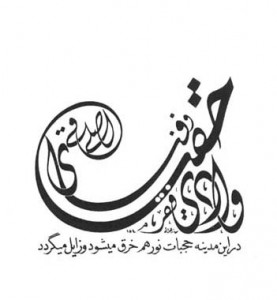 Will computers make extinct the last of Islam’s proud and honourable calligraphers?
Will computers make extinct the last of Islam’s proud and honourable calligraphers?
By Robert Fisk, Saturday 12 November 2011
…
Dr Jamal Naja meets me in a coffee shop just down the road from his home in Alamuddin Street, a quiet almost mischievous face, greying hair, and he lays – with great care – a black packet on the table in front of him.
Tripoli in northern Lebanon is an overwhelmingly Muslim city and Naja has a PhD in Islamic studies. But he is also a calligrapher and the black packet contains his pens and brushes. “Now, Robert, take these two pencils and drop them on the floor.” I do. One sounds low and hollow. The other sounds high and brittle. “The higher the note, the better the pencil,” he says.
Calligraphy is an Islamic rather than a mere Arabic form of art, partly because Muslims disapprove of the human image in religious work. Iran has at least 200 calligraphers but in Beirut, it is a dying art – Naja is one of 10 authentic calligraphers left – and the computer is slowly destroying these craftsmen. Naja picks a sheaf of glossy, bright pages and a tiny inkpot and his pens and pencils scream over the surface as if they are alive, louder than chalk on a blackboard.
I am reminded of illuminated bibles, for these are letters and words in the nearest you can get to pictures. Naja copies out a sura from the Koran and his pen screams and squeaks and screams, his script moving up and down the page, bottom to top, measured in the number of little “diamonds” – five at the most – and their place within and below the consonants, usually indicating vowels. In the past, this was also the language of government, of Ottoman Firmins and of authority. The ink is special, and they say it smells of oranges.
Naja calls his work “the trade of honour”, and I realise at once that 200 years ago, anyone who was literate would want to write like this, not only a proof of power, but of learning. How typical that our laptops are now destroying the literacy of the past. Naja still copies the text of the Koran and his eyes narrow in concentration. It is script and art and religion rolled into one. Who would today ever copy out the Bible by hand? I think of Lindisfarne, and the Book of Kells lying now in the great library of my old university of Trinity College, in Ireland.
“Calligraphy cannot be learned immediately – and it is a hobby as well as a practice,” Naja says. “There are Christian calligraphers, though not many. The script is hidden in revealing itself to the teacher. How can I explain it to you? My father was my first teacher. Then I travelled to Turkey, Egypt and many Arab countries, and I would learn, little by little, to create this experience.” I wonder if, in fact, calligraphy is a linguistic version of singing. Naja gives me a sidelong glance. “Given that the Koran is not poetry or regular when writing it, reading it is not as regular as singing. It has its own identity.”
The Prophet, famously, was himself illiterate – his words were copied down later – but Naja adds that “illiteracy does not mean lack of education – the Prophet was wise and spoke to calligraphers”. In olden times, they would receive a certificate of calligraphy, a practice that has now largely disappeared, although Naja himself has won international awards in calligraphy and has been a judge of calligraphic art. The Diwani script in which he is writing was developed under the Ottoman empire and perhaps the most famous calligraphy – still found on old fountains in Beirut – is the Ottoman official seal.
Naja is a serious man – you’d have to be to write like this – but he enjoys life as a university professor in Beirut. “I pray, of course, but I am an open person. I enjoy all countries and all civilisation. Islam is a moderate religion, not a fundamentalist one. It is a mix and an integration of civilisations.”
Alas, that will not maintain the calligraphers of the Middle East. Some earn their living today (though not Naja) by writing out restaurant menus or inscribing dinner menus for presidents. It seems a sad outcome of centuries of art, although Naja will be going for many years yet. And then I look at my own notes of our interview, in shabby pencil, in handwriting I can scarcely read. This is what writing with a computer has done for me. I have started to write not letters and words but the imitation of words, pictures of words where I now have to second-guess missing letters. I suspect this is because the laptop allows me to think faster than I can write and when I return to pencil, my words trip over each other.
Naja has started work on another sheet of paper and the screaming pen begins again. Then I realise there is a silk ribbon through the pen and that is what is screaming, the ink running on to the material and the pressure of the pen is applied to the silk. I slowly read as he writes. R-Wow-Bay-R-T-F-Yay-Sin-Kaf. “Robert Fisk,” it says in Arabic. And he writes his own name in tiny letters beneath: “Jamal Naja, Tripoli, on 5/11/2011.”
…
http://www.independent.co.uk/opinion/commentators/fisk/robert-fisk-will-computers-make-extinct-the-last-of-islams-proud-and-honourable-calligraphers-6261049.html or http://ind.pn/tDQM6c
Persian calligraphy by Zurhan Bahrai, “In the city, even the veils of light are split asunder and vanish away…” (Baha’u’llah). https://levantium.com/2010/11/29/burhan-zahrai/
